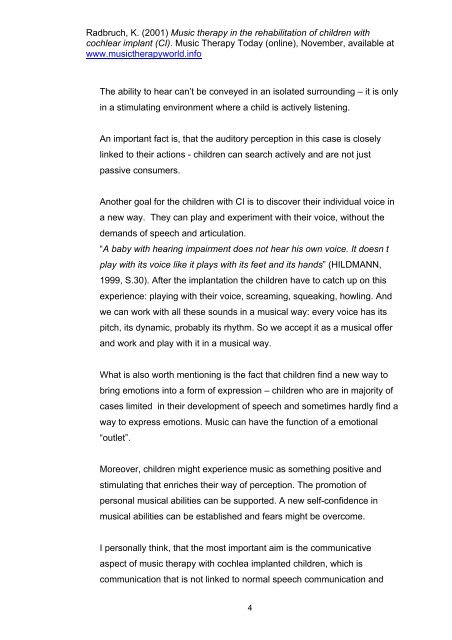Music therapy in the rehabilitation of children - World Federation of ...
Music therapy in the rehabilitation of children - World Federation of ...
Music therapy in the rehabilitation of children - World Federation of ...
You also want an ePaper? Increase the reach of your titles
YUMPU automatically turns print PDFs into web optimized ePapers that Google loves.
Radbruch, K. (2001) <strong>Music</strong> <strong><strong>the</strong>rapy</strong> <strong>in</strong> <strong>the</strong> <strong>rehabilitation</strong> <strong>of</strong> <strong>children</strong> with<br />
cochlear implant (CI). <strong>Music</strong> Therapy Today (onl<strong>in</strong>e), November, available at<br />
www.music<strong><strong>the</strong>rapy</strong>world.<strong>in</strong>fo<br />
The ability to hear can’t be conveyed <strong>in</strong> an isolated surround<strong>in</strong>g – it is only<br />
<strong>in</strong> a stimulat<strong>in</strong>g environment where a child is actively listen<strong>in</strong>g.<br />
• An important fact is, that <strong>the</strong> auditory perception <strong>in</strong> this case is closely<br />
l<strong>in</strong>ked to <strong>the</strong>ir actions - <strong>children</strong> can search actively and are not just<br />
passive consumers.<br />
• Ano<strong>the</strong>r goal for <strong>the</strong> <strong>children</strong> with CI is to discover <strong>the</strong>ir <strong>in</strong>dividual voice <strong>in</strong><br />
a new way. They can play and experiment with <strong>the</strong>ir voice, without <strong>the</strong><br />
demands <strong>of</strong> speech and articulation.<br />
“A baby with hear<strong>in</strong>g impairment does not hear his own voice. It doesn t<br />
play with its voice like it plays with its feet and its hands” (HILDMANN,<br />
1999, S.30). After <strong>the</strong> implantation <strong>the</strong> <strong>children</strong> have to catch up on this<br />
experience: play<strong>in</strong>g with <strong>the</strong>ir voice, scream<strong>in</strong>g, squeak<strong>in</strong>g, howl<strong>in</strong>g. And<br />
we can work with all <strong>the</strong>se sounds <strong>in</strong> a musical way: every voice has its<br />
pitch, its dynamic, probably its rhythm. So we accept it as a musical <strong>of</strong>fer<br />
and work and play with it <strong>in</strong> a musical way.<br />
• What is also worth mention<strong>in</strong>g is <strong>the</strong> fact that <strong>children</strong> f<strong>in</strong>d a new way to<br />
br<strong>in</strong>g emotions <strong>in</strong>to a form <strong>of</strong> expression – <strong>children</strong> who are <strong>in</strong> majority <strong>of</strong><br />
cases limited <strong>in</strong> <strong>the</strong>ir development <strong>of</strong> speech and sometimes hardly f<strong>in</strong>d a<br />
way to express emotions. <strong>Music</strong> can have <strong>the</strong> function <strong>of</strong> a emotional<br />
“outlet”.<br />
• Moreover, <strong>children</strong> might experience music as someth<strong>in</strong>g positive and<br />
stimulat<strong>in</strong>g that enriches <strong>the</strong>ir way <strong>of</strong> perception. The promotion <strong>of</strong><br />
personal musical abilities can be supported. A new self-confidence <strong>in</strong><br />
musical abilities can be established and fears might be overcome.<br />
• I personally th<strong>in</strong>k, that <strong>the</strong> most important aim is <strong>the</strong> communicative<br />
aspect <strong>of</strong> music <strong><strong>the</strong>rapy</strong> with cochlea implanted <strong>children</strong>, which is<br />
communication that is not l<strong>in</strong>ked to normal speech communication and<br />
4

















